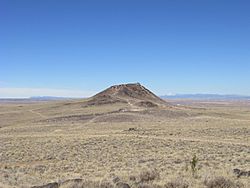Vulcan (inactive volcano) facts for kids
Quick facts for kids Vulcan |
|
|---|---|
 |
|
| Highest point | |
| Elevation | 6,033 ft (1,839 m) |
| Prominence | 600 ft (180 m) |
| Geography | |
| Location | Petroglyph National Monument Bernalillo County, New Mexico, U.S. |
| Geology | |
| Age of rock | > 10,000 years |
| Mountain type | Spatter cone |
| Last eruption | 150,000+ years ago |
Vulcan is a cool, inactive volcano near Albuquerque, New Mexico. It got its name from the Roman god of fire! It's the biggest of six volcanoes in the Albuquerque volcanic field. This area is part of Petroglyph National Monument.
Vulcan is a special type called a spatter cone volcano. It formed when hot lava shot up like fountains. This lava cooled and built up the cone. Some smaller lava vents on its sides even created arches and caves you can see today. Scientists think Vulcan last erupted about 150,000 years ago.
What is Vulcan Like?
Vulcan rises about 600 feet (183 meters) above the valley floor. From its top, you can clearly see how the five-mile-long chain of volcanoes lines up.
When lava blobs shoot out of a volcano, they are called "spatter." These blobs cool as they fly through the air. Then, they land on the volcano's side and stick together. This forms a hard outer crust.
On Vulcan's eastern and southern sides, you can see fragmented rock and lava flows. These layers tilt steeply away from the center. The spatter material is thickest on the southeast side. This shows that winds blew the lava toward the south and east during the eruptions.
Inside Vulcan's crater, there's a solidified lava pond. It's made of gray basalt rock. You can also find long, winding lava tubes on Vulcan's northeast and northwest sides. These tubes are about 8 to 20 inches (20 to 51 cm) wide and 300 feet (91 meters) long.
Where is Vulcan Located?
Vulcan is located in a huge geological area. It's called the Rio Grande rift. This rift follows the Rio Grande river. It stretches from southern Colorado down to El Paso, Texas.
A rift is like a giant crack in the Earth's surface. Here, two land masses are slowly pulling apart. This pulling motion causes a lot of the volcanic activity and mountain building in the area.
Vulcan is inside Petroglyph National Monument. You can visit the volcanoes during business hours. Just remember, vehicles are locked in after hours.
Vulcan is about 7 miles (11 km) northwest of Albuquerque. To the south, you'll find Black and JA volcano. To the north are Bond and Butte volcanoes. Beyond them are the Jemez Mountains. To the west, you can see the huge stratovolcano Mount Taylor. The Navajo people call it Tsoodził, or "The Turquoise Mountain." To the east are the cities of Rio Rancho, Albuquerque, and the village of Corrales. You can also see the Sandia Mountains there.
History of Vulcan
Scientists believe Vulcan last erupted around 150,000 years ago. The volcanoes in this area are considered inactive, or "dormant." This means they are not erupting now, but they could in the very distant future.
Measurements from Earth and space show that the ground above the Socorro Magma Body is slowly rising. It's moving up about 2 millimeters (0.08 inches) per year.
From 1951 to 1973, a large letter "J" was painted on Vulcan's eastern slope. This "J" stood for the College of St. Joseph on the Rio Grande. Because of this, people sometimes called it the "J Volcano" or "J Cone." Each fall, new students from the college would repaint the "J." In 1973, the "J" was painted over with a dark stain. You can still faintly see it today.

